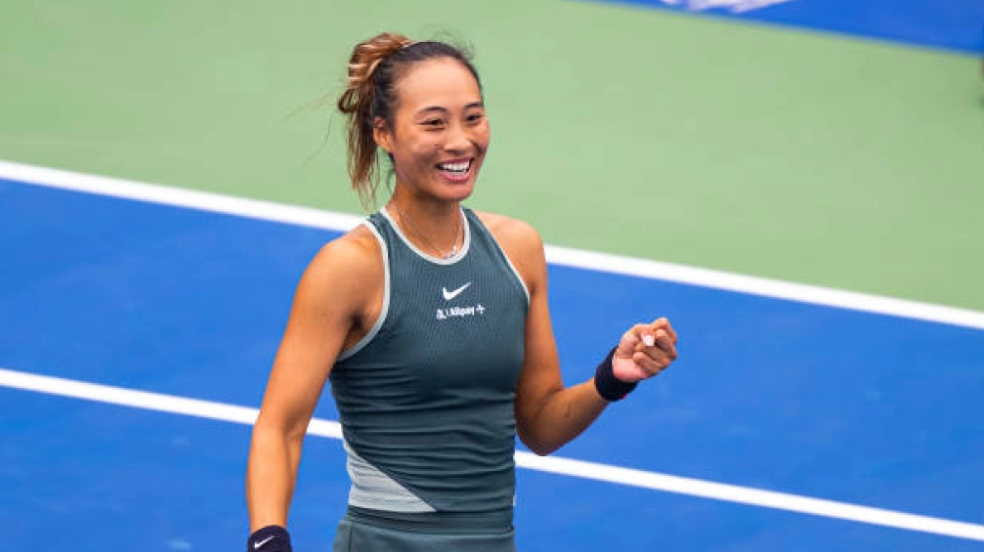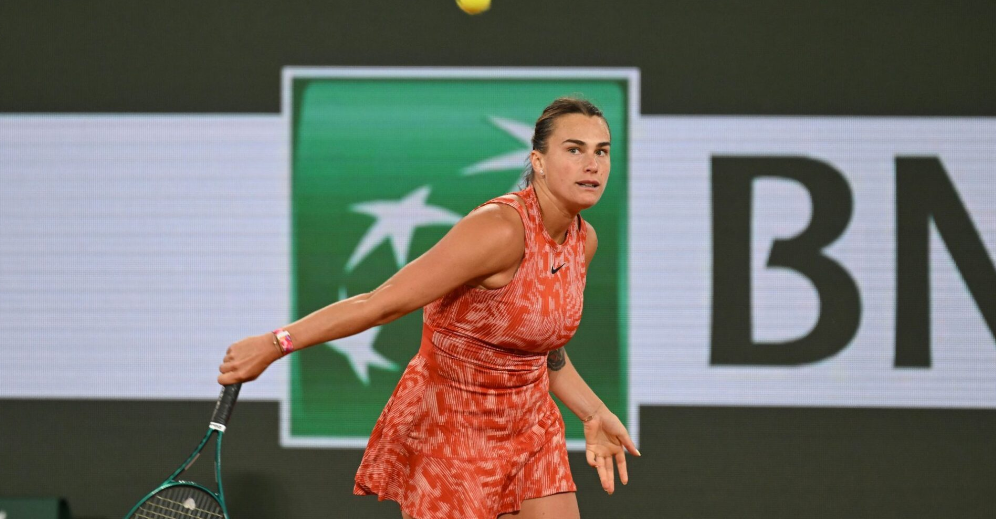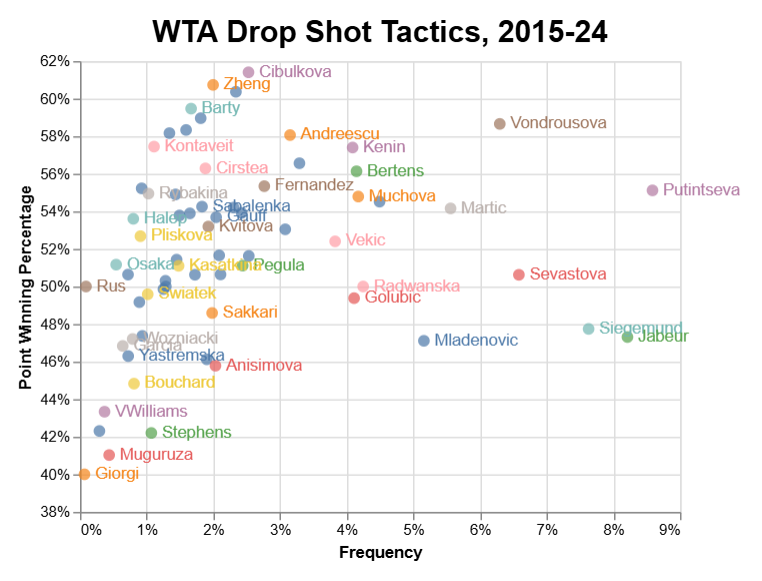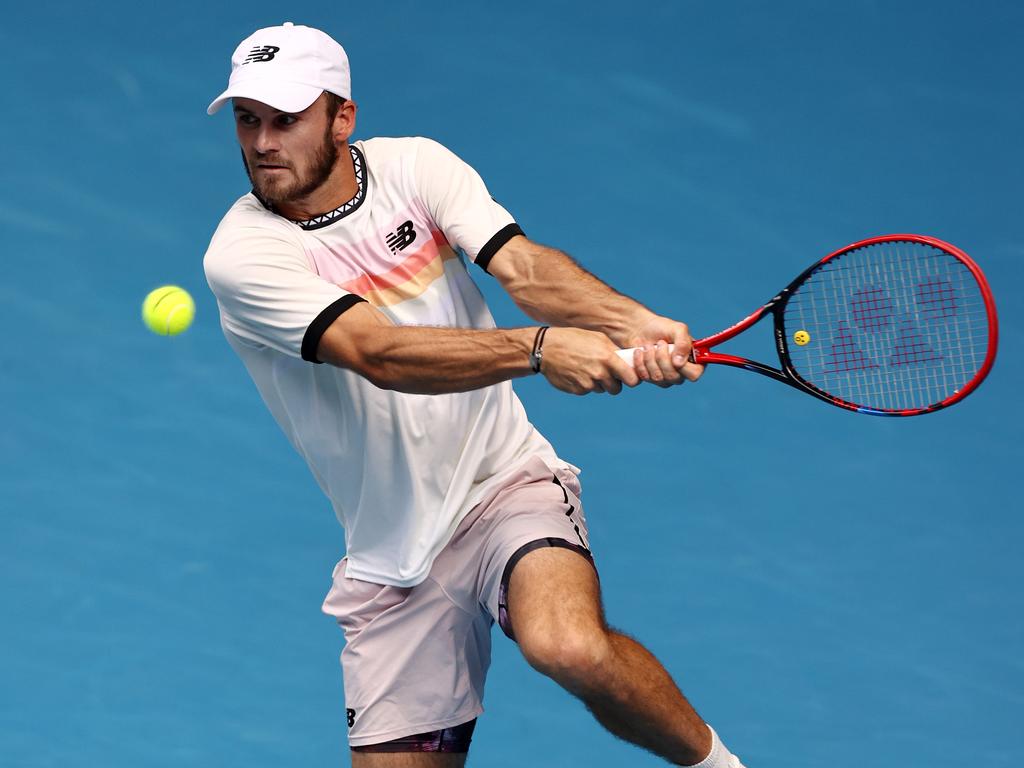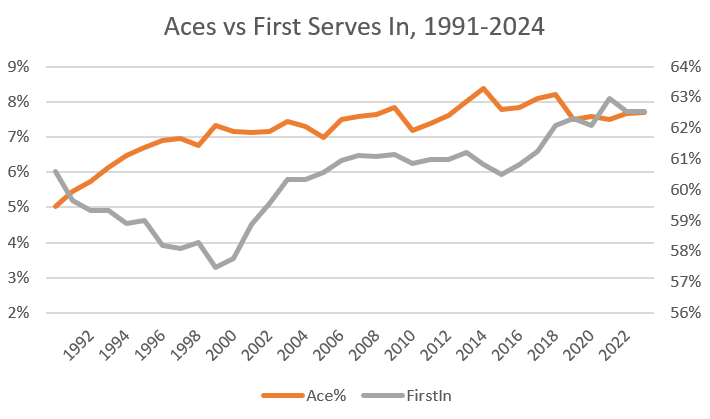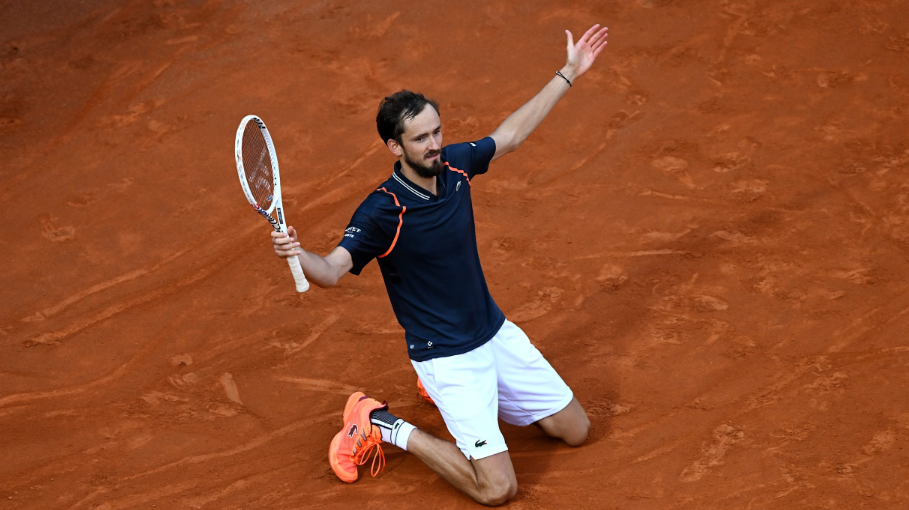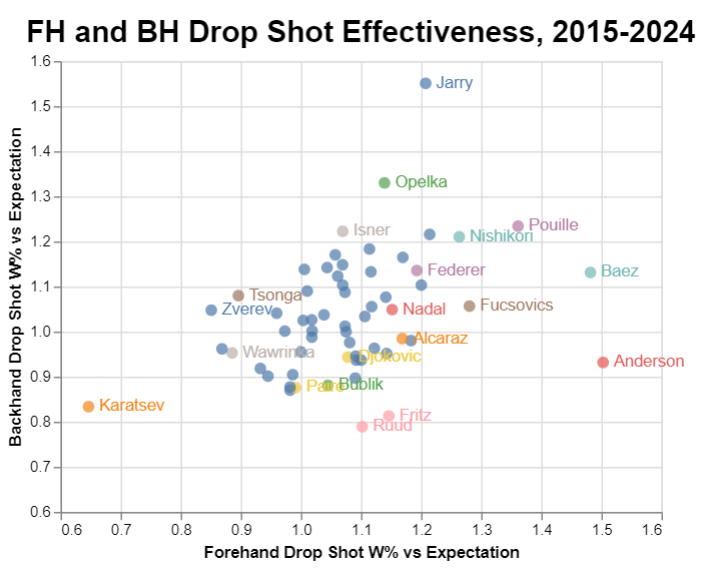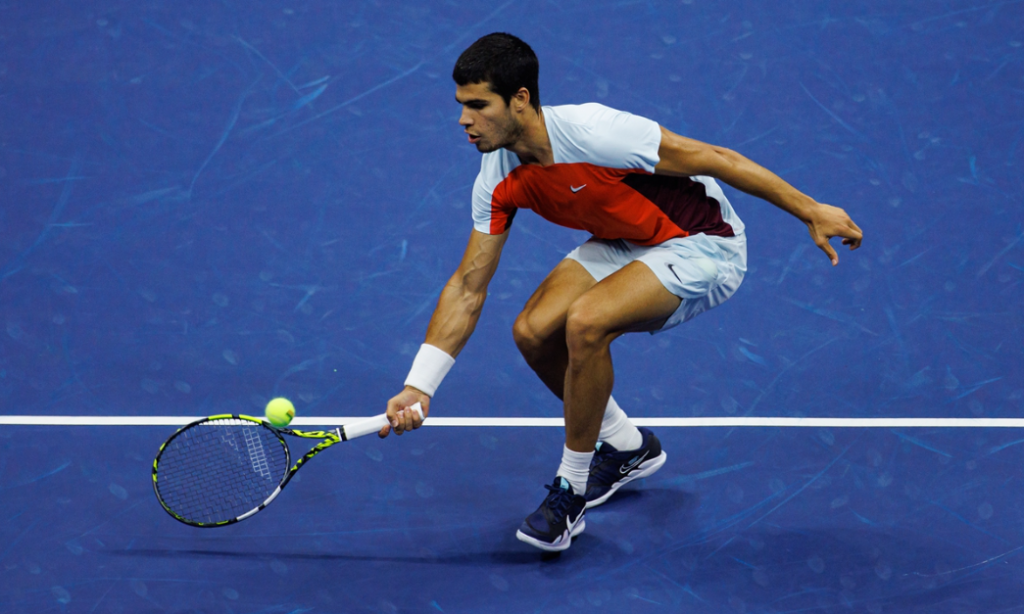
Taylor Fritz has been remarkably consistent over the last three seasons. He ended the 2022 campaign ranked 9th, finished last year 10th, and enters this week’s Tour Finals in 5th place, with a chance to overtake Daniil Medvedev for a spot in the top four.
Take a look at his top-line statistics for 2022, 2023, and 2024. They’re sorted by total points won (TPW). Can you tell which one belongs to his career-best current season?
Year Win% 1st% 2nd% RPW TPW ??? 68.8% 78.4% 54.3% 37.7% 53.0% ??? 70.4% 78.3% 55.8% 36.2% 52.8% ??? 69.1% 76.4% 52.6% 38.2% 52.4%
You might be tempted to go with the first row, since he won the most points then. But the margin is small, and he won matches at a better clip in the second. Wait, though: He snagged the most return points in the third season, and more breaks of serve are particularly crucial for a player hovering in the 36% to 38% range.
I won’t leave you hanging. The second line belongs to 2024. Here are the three stat lines, now sorted by season:
Year Win% 1st% 2nd% RPW TPW 2024 70.4% 78.3% 55.8% 36.2% 52.8% 2023 68.8% 78.4% 54.3% 37.7% 53.0% 2022 69.1% 76.4% 52.6% 38.2% 52.4%
The 27-year-old American is clearly doing something right that isn’t captured by the usual stats. 10th to 5th is a major move. Last year he didn’t even qualify for the Tour Finals. After beating Medvedev yesterday, he’s one win away from a probable berth in the semis. What’s going on here?
All the right matches
The official ranking system ensures that tournaments and matches are very much unequal. When Fritz beat Frances Tiafoe in the Acapulco quarter-finals last year, he gained an additional 90 points for his semi-final showing. When he slipped past Tiafoe in this year’s US Open for a place in the championship match, he earned a whopping 480 points.
I could just about stop here. 480 points is the difference between Fritz’s current point total and 8th place. A slightly bigger difference of 560 points would knock him down to 10th, and he’d be hanging around Turin this week as an alternate. His stats would barely change, but the story of his season would be very different.
It’s not just the Tiafoe match; it’s more than the US Open final. 2024 was the first year that Fritz lived up to expectations at the slams in general. Here are his grand-slam win totals back to 2018:
Year Wins 2024 17 2023 8 2022 8 2021 6 2020 6 * no Wimbledon 2019 4 2018 4
No top tenner would be happy with just eight wins at majors. Simply reaching the fourth round at each slam adds up to 12. In 2022, Fritz lost five-setters to Stefanos Tsitsipas and Rafael Nadal, then fell to a streaking Brandon Holt in Flushing. Last year, he suffered two second-round exits. Both five-setters, the losses came against Alexei Popyrin in Australia and Mikael Ymer at Wimbledon.
When the 2024 season kicked off, Fritz had just two major quarter-finals to his name. His career record in five-setters was 8-10.
Since then, the American has reached three more quarters (including the US Open final run). He won four five-setters against just one defeat. He avenged the Melbourne loss to Tsitsipas and twice upset Alexander Zverev, a player who had beaten him in five of eight previous meetings.
The re-balancing
The odd thing about Fritz’s season is that his slam success has been offset by weaker results elsewhere. Returning to the observation I started with: He won nine more matches at majors in 2024 than in 2023, but his winning percentage barely budged. Instead of losing to Ymer or Holt on a big stage, he fell to Matteo Arnaldi in Acapulco, Thiago Seyboth Wild in Miami, Alex Michelsen in Geneva, and more.
It was a smart trade, though it was surely not a premeditated one. You can train with the majors in mind, but you can hardly punt an early-round match at a 250 with any kind of hope that it will result in a quarter-final victory at the next slam.
There’s another category, though, in which Fritz may have used stronger tactics to get better “luck.” Here are the American’s tiebreak records since 2021:
Year TB W-L TB% 2024 21-11 65.6% 2023 25-17 59.5% 2022 24-20 54.5% 2021 20-15 57.1%
The 2023 mark of 59% is about where Fritz should be, based on the rate at which he normally wins serve and return points, combined with the matches in which he finds himself in tiebreaks. 2024 was the first season he beat tiebreak expectations by a non-negligible margin.
This could be luck. Tiebreak records fluctuate, and very few players sustain records above or below expectations for long. Still, the American might have figured something out. In the sample of 2024 matches logged by the Match Charting Project (plus several others from grand slams), Fritz is serving way better in tiebreaks than he has in the past:
Year TB SPW 2024 80.3% 2023 65.6% 2022 70.9% 2021 65.0%
80% is Isner territory. In the improbable event that Fritz can sustain these kinds of numbers, coupled with a solid return-points-won rate around 38%, he should be winning even more tiebreaks than he already does.
I don’t want to overemphasize tiebreaks: After all, his 21-11 record is only one or two tiebreaks better than it “should” be. On the other hand, it’s easy to scan through Fritz’s career results–including those at majors–and see how one or two tiebreaks could change the story. He took a first-set tiebreak from Tsitsipas in Melbourne this year. He split two against Zverev at Wimbledon, then took two of two from the German in New York. Take one of those away–just one!–and again, he might be watching the Tour Finals from the sidelines.
Zverev tolerance
Regardless of whether tiebreak luck played a role, Fritz’s two major victories over Zverev helped to define his season. Neither pre-match betting odds nor my Elo ratings predicted an American victory on either occasion.
Both Fritz and Zverev are tall guys with big serves; either one can put away a service game with four quick strikes. One key difference between them is that Zverev is more patient, comfortable playing long points from the baseline. This isn’t necessarily an asset: It isn’t always in the German’s interest to let matches go that way. But if you’re going to pick one of these two guys to play points from the baseline, it’s pretty clearly Zverev.
In the US Open quarter-final, though, 39 points went ten strokes or longer. Fritz won 20 of them. In the fourth-set tiebreak, three and half hours into the battle, the American won two of two: a 24-stroke grinder that Fritz finished at the net, then a 12-shotter on match point that Zverev squandered with a unforced forehand error.
Two lessons jump out. First, the American can hold his own from the backcourt with one of the best baseliners in the game, at least on a hard court. Second, that skill doesn’t seem to fade with fatigue, something that might have caused Fritz’s five-set struggles in the past.
A third takeaway may be even more important. Instead of the numerator–20 points won–consider the denominator: 39 points played. The first time Fritz and Zverev met at a major, at Wimbledon back in 2018, barely half as many points lasted so long, even though the match itself was longer. Yes, the surface kept that number down, but not by a factor of two. At Washington early in Fritz’s career, on a surface more like that in Flushing, the two men played an entire match with just one rally that reached ten strokes.
In that 2018 Wimbledon meeting, Fritz held his own in the long rallies, winning 9 of 21. The problem was his rush to avoid them. He committed 56 unforced errors to the German’s 36.
Zverev keeps his unforced error rates down because he is willing to wait. He forces opponents to take risks unless they want to spend all day grinding out baseline battles. Most players in the Fritz mold–including Fritz himself, in the past–opt to take their chances. They usually lose, which is why Zverev is ranked second in the world. The American has steadily improved his groundstrokes and his fitness to the point that he doesn’t need to take low-percentage big swings. It’s no guarantee of victory–after all, Fritz won just 50.9% of points in the Flushing four-setter–but it’s a better bet than the alternative.
Let’s play ten
There’s a wider lesson here, and not just for Taylor Fritz. We tend to think of long-rally proficiency as a clear-cut skill. Yes, some players are better at it than others, but not by a wide margin.
Here are the long-rally (10+ shots) winning percentages for the ATP top ten, based on Match Charting Project data for the last 52 weeks:
Player 10+ W% Alex de Minaur 57.4% Carlos Alcaraz 57.1% Jannik Sinner 55.8% Daniil Medvedev 55.0% Grigor Dimitrov 54.2% Novak Djokovic 52.8% Andrey Rublev 51.8% Casper Ruud 50.2% Alexander Zverev 50.2% Taylor Fritz 46.8%
Before I studied this, I would’ve expected considerably more dispersion. While every edge counts, this one is not as crucial as it gets credit for. Fewer than one in ten points reach the long-rally threshold, so even the most extreme gaps–like that between Fritz and de Minaur here–would determine the outcome of only the closest matches.
More important, I suspect, is willingness to play these points. Fritz is never going to crack the top half of a list like this. He has–to his credit–maxed out the rally tolerance that his size and physical gifts will grant him. Still, a 47% chance of winning a protracted point is better than his odds after belting a low-percentage salvo to avoid the battle altogether.
Players who serve as effectively as Fritz does tend to be considerably less sturdy from the baseline. Pros with his (adequate if not world-beating) groundstrokes are often less inclined to rely on them. One-dimensional big servers almost never reach the top five. Yet Fritz, combining his primary weapon with a tactical savvy that allows him to maximize the rest of his assets, has done exactly that.
* * *
Subscribe to the blog to receive each new post by email:
